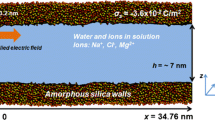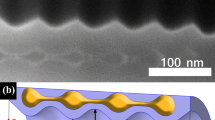Abstract
The characteristic high surface area to volume ratio causes ionic transport in nanofluidic devices to be governed by surface properties like surface charge. In recent years, experimental demonstrations have shown gate electrodes embedded in the nanochannel wall to systematically alter the surface potential to manipulate ionic transport in nanochannels. Using state-of-the-art non-equilibrium molecular dynamics simulations, electrokinetic transport of an aqueous KCl solution confined in a ~7 nm deep silica nanochannel is reported under the influence of asymmetric surface charge to investigate the effect of engineered surface charge on the resulting velocity and ion number density profiles within these nanochannels. Significant changes in the velocity magnitude and profile were observed in the silica nanochannels with two charged surface patches compared to a homogenously charged silica channel. The surface charged patches cause regions of local flow reversal which were indicated by an observed negative velocity. The simulations provide a theoretical foundation to systematically manipulate electrokinetic flow inside nanochannels by using engineered surface charge at the nanochannel walls.








Similar content being viewed by others
References
Ai Y, Liu J, Zhang B, Qian S (2011) Ionic current rectification in a conical nanofluidic field effect transistor. Sens Actuators B Chem 157:742–751
Berendsen HJC, Postma JPM, van Gunsteren WF, DiNola A, Haak JR (1984) Molecular dynamics with coupling to an external bath. J Chem Phys 81(8):3684
Berendsen HJC, Grigera JR, Straatsma TP (1987) The missing term in effective pair potentials. J Phys Chem 91:6269–6271
Bhadauria R, Aluru NR (2013) A quasi-continuum hydrodynamic model for slit shaped nanochannel flow. J Chem Phys 139(7):074109
Cannon DM Jr, Flachsbart BR, Shannon MA, Sweedler JV, Bohn PW (2004) Fabrication of single nanofluidic channels in poly(methylmethacrylate) films via focused-ion beam milling for use as molecular gates. Appl Phys Lett 85:1241
Chen L, Conlisk AT (2009) Effect of nonuniform surface potential on electroosmotic flow at large applied electric field strength. Biomed Microdevices 11(1):251–258
Chen Y, Ni Z, Wang G, Xu D, Li D (2007) Electroosmotic flow in nanotubes with high surface charge densities. Nano Lett 8(1):42–48
Conlisk AT (2013) Essentials of micro- and nanofluidics. Cambridge University Press, New York
Contento NM, Bohn PW (2014) Tunable electrochemical pH modulation in a microchannel monitored via the proton-coupled electro-oxidation of hydroquinone. Biomicrofluidics 8: 044120–044121, 044120–044129
Cruz-Chu ER, Aksimentiev A, Schulten K (2006) Water-silica force field for simulating nanodevices. J Phys Chem B 110:21497–21508
Daiguji H (2010) Ion transport in nanofluidic channels. Chem Soc Rev 39:901–911
Daiguji H, Oka Y, Shirono K (2005) Nanofluidic diode and bipolar transistor. Nano Lett 5(11):2274–2280
Erickson D, Sinton D, Psaltis D (2011) Optofluidics for energy applications. Nat Photonics 5:583–590
Freund JB (2002) Electroosmosis in a nanometer-scale channel studied by atomistic simulation. J Comput Phys 116(5):2194–2200
Fuest M, Boone C, Rangharajan KK, Conlisk AT, Prakash S (2015) A three-state nanofluidic field effect switch. Nano Lett 15(4):2365–2371. doi:10.1021/nl5046236
Guan W, Fan R, Reed MA (2011) Field-effect reconfigurable nanofluidic ionic diodes. Nat Commun 2:506. doi:10.1038/ncomms1514
Guan W, Li SX, Reed MA (2014) Voltage gated ion and molecule transport in engineered nanochannels: theory, fabrication and applications. Nanotechnology 25(12):122001. doi:10.1088/0957-4484/25/12/122001
Guissani Y, Guillot B (1996) A numerical investigation of the liquid–vapor coexistence curve of silica. J Chem Phys 104:7633–7644
Hassanali AA, Singer SJ (2007) Model for the water-amorphous silica interface: the undissociated surface. J Phys Chem B 111:11181–11193
Hu N, Ai Y, Qian S (2012) Field effect control of electrokinetic transport in micro/nanofluidics. Sens Actuators B Chem 161:1150–1167
Huff NT, Demiralp E, Cagin T, Goddard WA (1999) Factors affecting molecular dynamics simulated vitreous silica structures. J Non Cryst Solids 253:133–142
Jiang Z, Stein D (2011) Charge regulation in nanopore ionic field-effect transistors. Phys Rev E Stat Nonlinear Soft Matter Phys 83:1–6
Jin X, Aluru NR (2011) Gated transport in nanofluidic devices. Microfluid Nanofluid 11(3):297–306
Joseph S, Aluru NR (2006) Hierachical multiscale simulation of electrokinetic transport in silica nanochannels at the point of zero charge. Langmuir 22(21):9041–9051
Kalman EB, Sudre O, Vlassiouk I, Siwy ZS (2009) Control of ionic transport through gated single conical nanopores. Anal Bioanal Chem 394:413–419
Karniadakis G, Beskok A, Aluru N (2001) Microflows: fundamentals and simulation. Springer, Berlin
Karnik R, Fan R, Yue M, Li D, Yang P, Majumdar A (2005) Electrostatic control of ions and molecules in nanofluidic transistors. Nano Lett 5(5):943–948
Kim D, Darve E (2006) Molecular dynamics simulation of electroosmotic flows in rough wall nanochannels. Phys Rev E 73:051203
Kim SJ, Song YA, Han J (2010) Nanofluidic concentration devices for biomolecules utilizing ion concentration polarization: theory, fabrication, and applications. Chem Soc Rev 39:912–922
Ko SH, Song Y-A, Kim SJ, Kim M, Han J, Kang KH (2012) Nanofluidic preconcentration device in a straight microchannel using ion concentration polarization. Lab Chip 12:4472–4482
Kuo T-C, Donald J, Cannon M, Chen Y, Tulock JJ, Shannon MA, Sweedler JV, Bohn PW (2003a) Gateable nanofluidic interconnects for multilayered microfluidic separation systems. Anal Chem 75(8):1861–1867
Kuo T-C, Cannon DM Jr, Shannon MA, Bohn PW, Sweedler JV (2003b) Hybrid three-dimensional nanofluidic/microfluidic devices using molecular gates. Sens Actuators A 102(3):223–233
Lee S-H, Lee H, Jin T, Park S, Yoon BJ, Sung GY, Kim K-B, Kim SJ (2015) Sub-10 nm transparent all-around-gated ambipolar ionic field effect transistor. Nanoscale 7(3):936–946
Liu Y, Huber DE, Dutton RW (2010a) Limiting and overlimiting conductance in field-effect gated nanopores. Appl Phys Lett 96:253108. doi:10.1063/1.3457350
Liu Y, Huber DE, Tabard-Cossa V, Dutton RW (2010b) Descreening of field effect in electrically gated nanopores. Appl Phys Lett 97:143109. doi:10.1063/1.3497276
Lorenz CD, Crozier PS, Anderson JA, Travesset A (2008) Molecular dynamics of ionic transport and electrokinetic effects in realistic silica channels. J Phys Chem C 112:10222–10232
Lyklema J (1995) Fundamentals of interface and colloid science. Academic Press, San Diego
Ma C, Contento NM, Bohn PW (2014a) Redox cycling on recessed ring-disk nanoelectrode arrays in the absence of supporting electrolyte. J Am Chem Soc 136:7225–7228
Ma Y, Xue S, Hsu S-C, Yeh L-H, Qian S, Tana H (2014b) Programmable ionic conductance in a pH-regulated gated nanochannel. Phys Chem Chem Phys 16:20138–21046
Maleki T, Mohammadi S, Ziaie B (2009) A nanofluidic channel with embedded transverse electrodes. Nanotechnology 20:1–6
Nam SW, Rooks MJ, Kim KB, Rossnagel SM (2009) Ionic field effect transistors with sub-10 nm multiple nanopores. Nano Lett 9(5):2044–2048
Oyarzua E, Walther JH, Meija A, Zambrano HA (2015) Early regimes of water capillary flow in slit silica nanochannels. Phys Chem Chem Phys 17:14731–14739
Pardon G, van der Wijngaart W (2013) Modeling and simulation of electrostatically gated nanochannels. Adv Colloid Interface Sci 199–200:78–94
Pennathur S, Santiago JG (2005) Electrokinetic transport in nanochannels. 1. Theory. Anal Chem 77:6772–6781
Pinti M, Zambrano HA, Rangharajan KK, Wang B, Conlisk AT, Prakash S (2014) Active surface charge control for artificial ion pumps. Hilton head workshop 2014: a solid-state sensors, actuators and microsystems workshop Hilton Head, Transducers Research Foundation, South Carolina
Prakash S, Yeom J (2014) Nanofluidics and microfluidics: systems and applications. William Andrew, Norwich
Prakash S, Piruska A, Gatimu EN, Bohn PW, Sweedler JV, Shannon MA (2008) Nanofluidics: systems and applications. IEEE Sens J 8(5):441–450
Prakash S, Karacor MB, Banerjee S (2009) Surface modification in microsystems and nanosystems. Surf Sci Rep 64(7):233–254
Prakash S, Pinti M, Bhushan B (2012) Theory, fabrication and applications of microfluidic and nanofluidic biosensors. Philos Trans R Soc A Math Phys Eng Sci 370(1967):2269–2303
Probstein RE (2003) Physiochemical hydrodynamics: an introduction. Wiley, Hoboken
Qiao R, Aluru NR (2003) Ion concentrations and velocity profiles in nanochannel electroosmotic flows’. J Chem Phys 118(10):4692–4701
Qiao R, Aluru NR (2004) Charge inversion and flow reversal in a nanochannel electro-osmotic flow. Phys Rev Lett 92:198301. doi:10.1103/PhysRevLett.92.198301
Qiao R, Aluru NR (2005) Surface-charge-induced asymmetric electrokinetic transport in confined silicon nanochannels. Appl Phys Lett 86(14):1–3
Qiao R, Georgiadis JG, Aluru NR (2006) Differential ion transport induced electroosmosis and internal recirculation in heterogeneous osmosis membranes. Nano Lett 6(5):995–999
Rangharajan KK, Kwak KJ, Conlisk AT, Wu Y, Prakash S (2015) Effect of surface modification on interfacial nanobubble morphology and contact line tension. Soft Matter 11(26):5214–5223
Ryckaert JP, Ciccotti G, Berendsen HJC (1977) Numerical integration of the cartesian equations of motion of a system with constraints: molecular dynamics of n-alkanes. J Comput Phys 23:327–341
Schoch RB, Han J, Renaud P (2008) Transport phenomena in nanofluidics. Rev Mod Phys 80:839–883
Singh KP, Kumar M (2012) Effect of gate length and dielectric thickness on ion and fluid transport in a fluidic nanochannel. Lab Chip 12:1332–1339
Singh KP, Kumari K, Kumar M (2011) Field-effect control of electrokinetic ion transport in a nanofluidic channel. J Appl Phys 110:084301. doi:10.1063/1.3651634
Suk ME, Aluru NR (2013) Molecular and continuum hydrodynamics in graphene nanopores. RSC Adv 3(24):9365–9372
Swaminathan VV, Gibson LR II, Pinti M, Prakash S, Bohn PW, Shannon MA (2012) Ionic transport in nanocapillary membrane systems. J Nanopart Res 14(8):951–965
Tseng S, Tai Y-H, Hsu J-P (2013) Electrokinetic flow in a pH-regulated, cylindrical nanochannel containing multiple ionic species. Microfluid Nanofluid 15:847–857
Tsuneyuki S, Tsukada M, Aoki H, Matsui Y (1988) First-principles interatomic potential of silica applied to molecular dynamics. Phys Rev Lett 61(7):869–874
Walther JH, Jaffe R, Halicioglu T, Koumoutsakos P (2001) Carbon nanotubes in water: structural characteristics and energetics. J Phys Chem B 105:9980–9987
Walther JH, Werder T, Jaffe RL, Gonnet P, Bergdorf M, Zimmerli U, Koumoutsakos P (2004a) Water-carbon interactions III: the influence of surface and liquid impurities. Phys Chem Chem Phys 6:1988–1995
Walther JH, Werder T, Jaffe RL, Koumoutsakos P (2004b) Hydrodynamic properties of carbon nanotubes. Phys Rev E 69:062201
Xue S, Yeh L-H, Ma Y, Qian S (2014) Tunable streaming current in a pH-regulated nanochannel by a field effect transistor. J Phys Chem C 118(12):6090–6099
Yang AHJ, Moore SD, Schmidt BS, Klug M, Lipson M, Erickson D (2008) Optical manipulation of nanoparticles and biomolecules in sub-wavelength slot waveguides. Nature 457:71–75
Yoshida H, Mizuno H, Kinjo T, Washizu H, Barrat J-L (2014) Molecular dynamics simulation of electrokinetic flow of an aqueous electrolyte solution in nanochannels. J Chem Phys 140:214701
Zaino LP, Contento NM, Bohn PW (2014) Electron transfer and electrokinetics in nanochannnels presenting multiple embedded annular nanoband electrodes in the strong coupling limit. Chem Electro Chem. doi:10.1002/ac5020222
Zambrano HA, Pinti M, Conlisk AT, Prakash S (2012) Electrokinetic transport in a water–chloride nanofilm in contact with a silica surface with discontinuous charged patches. Microfluid Nanofluid 13(5):735–747
Zambrano HA, Walther JH, Jaffe RL (2014) Molecular dynamics simulations of water on a hydrophilic silica surface at high pressures. J Mol Liq 198:107–113
Zhang H, Hassanali AA, Shin YK, Knight C, Singer SJ (2011) The water-amorphous silica interface: analysis of the Stern layer and surface conduction. J Comput Phys 134:1–13
Zhu W, Singer SJ, Zheng Z, Conlisk AT (2005) Electro-osmotic flow of a model electrolyte. Phys Rev E 71:041501
Zimmerli U, Gonnet P, Walther JH, Koumoutsakos P (2005) Curvature induced L-defects in water conduction in carbon nanotubes. Nano Lett 5(6):1017–1022
Acknowledgments
The authors acknowledge partial financial support from Defense Advanced Research Projects Agency (DARPA) through the US Army Research Office (ARO) Grant W911NF09C0079, the US Army Research Office (ARO) for Grant W911NF1010290, and NSF CBET-1335946. M. Fuest would like to thank the NSF graduate fellowship program for support. The authors wish to acknowledge discussions with Jim Giuliani and Kaushik K. Rangharajan in the Mechanical Engineering Department at OSU. We thank the Ohio Supercomputer Center (OSC) for computational support.
Author information
Authors and Affiliations
Corresponding authors
Rights and permissions
About this article
Cite this article
Prakash, S., Zambrano, H.A., Fuest, M. et al. Electrokinetic transport in silica nanochannels with asymmetric surface charge. Microfluid Nanofluid 19, 1455–1464 (2015). https://doi.org/10.1007/s10404-015-1659-0
Received:
Accepted:
Published:
Issue Date:
DOI: https://doi.org/10.1007/s10404-015-1659-0




